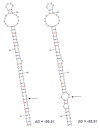Novel genetic variants in miR-191 gene and familial ovarian cancer
- PMID: 20167074
- PMCID: PMC2831822
- DOI: 10.1186/1471-2407-10-47
Novel genetic variants in miR-191 gene and familial ovarian cancer
Abstract
Background: Half of the familial aggregation of ovarian cancer can't be explained by any known risk genes, suggesting the existence of other genetic risk factors. Some of these unknown factors may not be traditional protein encoding genes. MicroRNA (miRNA) plays a critical role in tumorigenesis, but it is still unknown if variants in miRNA genes lead to predisposition to cancer. Considering the fact that miRNA regulates a number of tumor suppressor genes (TSGs) and oncogenes, genetic variations in miRNA genes could affect the levels of expression of TSGs or oncogenes and, thereby, cancer risk.
Methods and results: To test this hypothesis in familial ovarian cancer, we screened for genetic variants in thirty selected miRNA genes, which are predicted to regulate key ovarian cancer genes and are reported to be misexpressed in ovarian tumor tissues, in eighty-three patients with familial ovarian cancer. All of the patients are non-carriers of any known BRCA1/2 or mismatch repair (MMR) gene mutations. Seven novel genetic variants were observed in four primary or precursor miRNA genes. Among them, three rare variants were found in the precursor or primary precursor of the miR-191 gene. In functional assays, the one variant located in the precursor of miR-191 resulted in conformational changes in the predicted secondary structures, and consequently altered the expression of mature miR-191. In further analysis, we found that this particular variant exists in five family members who had ovarian cancer.
Conclusions: Our findings suggest that there are novel genetic variants in miRNA genes, and those certain genetic variants in miRNA genes can affect the expression of mature miRNAs and, consequently, might alter the regulation of TSGs or oncogenes. Additionally, the variant might be potentially associated with the development of familial ovarian cancer.
Figures





Similar articles
-
Novel genetic variants in microRNA genes and familial breast cancer.Int J Cancer. 2009 Mar 1;124(5):1178-82. doi: 10.1002/ijc.24008. Int J Cancer. 2009. PMID: 19048628
-
A functional polymorphism in the miR-146a gene and age of familial breast/ovarian cancer diagnosis.Carcinogenesis. 2008 Oct;29(10):1963-6. doi: 10.1093/carcin/bgn172. Epub 2008 Jul 27. Carcinogenesis. 2008. PMID: 18660546
-
Screening for BRCA1, BRCA2, CHEK2, PALB2, BRIP1, RAD50, and CDH1 mutations in high-risk Finnish BRCA1/2-founder mutation-negative breast and/or ovarian cancer individuals.Breast Cancer Res. 2011 Feb 28;13(1):R20. doi: 10.1186/bcr2832. Breast Cancer Res. 2011. PMID: 21356067 Free PMC article.
-
Epithelial-mesenchymal transition-associated miRNAs in ovarian carcinoma, with highlight on the miR-200 family: prognostic value and prospective role in ovarian cancer therapeutics.Cancer Lett. 2014 Sep 1;351(2):173-81. doi: 10.1016/j.canlet.2014.05.022. Epub 2014 Jun 18. Cancer Lett. 2014. PMID: 24952258 Review.
-
Clinically relevant microRNAs in ovarian cancer.Mol Cancer Res. 2015 Mar;13(3):393-401. doi: 10.1158/1541-7786.MCR-14-0424. Epub 2014 Oct 10. Mol Cancer Res. 2015. PMID: 25304686 Free PMC article. Review.
Cited by
-
MiR-191 inhibits TNF-α induced apoptosis of ovarian endometriosis and endometrioid carcinoma cells by targeting DAPK1.Int J Clin Exp Pathol. 2015 May 1;8(5):4933-42. eCollection 2015. Int J Clin Exp Pathol. 2015. PMID: 26191186 Free PMC article.
-
The clinical significance and regulation mechanism of hypoxia-inducible factor-1 and miR-191 expression in pancreatic cancer.Tumour Biol. 2014 Nov;35(11):11319-28. doi: 10.1007/s13277-014-2452-5. Epub 2014 Aug 14. Tumour Biol. 2014. PMID: 25119596
-
Mutations in the let-7 binding site - a mechanism of RAS activation in juvenile myelomonocytic leukemia?Haematologica. 2010 Sep;95(9):1616. doi: 10.3324/haematol.2010.024984. Epub 2010 May 11. Haematologica. 2010. PMID: 20460640 Free PMC article. No abstract available.
-
Glioma-Associated Mesenchymal Stromal/Stem Cells Derived Exosomal miR-191 Promotes the Proneural-to-Mesenchymal Transition in Glioblastoma Cells via PTEN/PI3K/AKT Signaling.Int J Nanomedicine. 2025 Jul 7;20:8811-8831. doi: 10.2147/IJN.S515771. eCollection 2025. Int J Nanomedicine. 2025. PMID: 40657483 Free PMC article.
-
Similar miRNomic signatures characterize the follicular fluids collected after follicular and luteal phase stimulations in the same ovarian cycle.J Assist Reprod Genet. 2020 Jan;37(1):149-158. doi: 10.1007/s10815-019-01607-6. Epub 2019 Nov 7. J Assist Reprod Genet. 2020. PMID: 31701304 Free PMC article.
References
-
- Yancik R. Ovarian cancer. Age contrasts in incidence, histology, disease stage at diagnosis, and mortality. Cancer. 1993;71(2 Suppl):517–23. - PubMed
-
- Narod SA, Ford D, Devilee P, Barkardottir RB, Lynch HT, Smith SA, Ponder BAJ, Weber BL, Garber JE, Birch JM, Cornelis RS, Kelsell DP, Spurr NK, Smyth E, Haites N, Sobol H, Bignon Y-J, Chang-Claude J, Hamann U, Lindblom A, Borg A, Piver MS, Gallion HH, Struewing JP, Whittemore A, Tonin P, Goldgar DE, Easton DF. An evaluation of genetic heterogeneity in 145 breast-ovarian cancer families. Am J Hum Genet. 1995;56:254–264. - PMC - PubMed
-
- Ford D, Easton DF, Stratton M, Narod S, Goldgar D, Devilee P, Bishop DT, Weber B, Lenoir G, Chang-Claude J, Sobol H, Teare MD, Struewing J, Arason A, Scherneck S, Peto J, Rebbeck TR, Tonin P, Neuhausen S, Barkardottir R, Eyfjord J, Lynch H, Ponder BA, Gayther SA, Zelada-Hedman M. Genetic heterogeneity and penetrance analysis of the BRCA1 and BRCA2 genes in breast cancer families. Am J Hum Genet. 1998;62:676–689. doi: 10.1086/301749. - DOI - PMC - PubMed
-
- Lynch HT, Albano WA, Lynch JF, Lynch PM, Campbell A. Surveillance and management of patients at high genetic risk for ovarian carcinoma. Obstet Gynecol. 1982;59:589–596. - PubMed
Publication types
MeSH terms
Substances
LinkOut - more resources
Full Text Sources
Other Literature Sources
Medical
Miscellaneous

